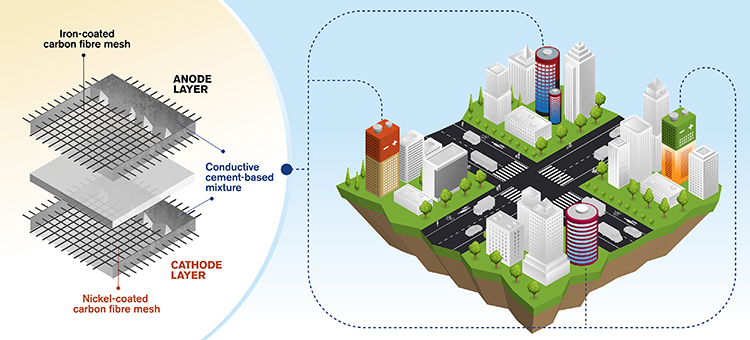May 19 2021
Envision an entire 20-story concrete building that is capable of storing energy similar to a massive battery. Now, an exclusive study performed by the Chalmers University of Technology in Sweden could someday make this vision a reality.
 Rechargeable cement-based batteries utilized as functional concrete. Image Credit: Yen Strandqvist.
Rechargeable cement-based batteries utilized as functional concrete. Image Credit: Yen Strandqvist.
Scientists from the Department of Architecture and Civil Engineering have recently reported an article describing a novel concept for rechargeable batteries—composed of cement.
The ubiquitous demand for sustainable building materials presents significant challenges to scientists. Dr Emma Zhang, formerly from the Chalmers University of Technology, Sweden, collaborated with Professor Luping Tang’s research team many years ago to look for futuristic building materials.
Now, working closely, the team has successfully designed a world-first concept for a cement-based rechargeable battery.
The concept first involves a cement-based mixture, with minimum quantities of short carbon fibers added to boost the flexural toughness and conductivity. Then, a metal-coated carbon-fiber mesh—nickel for the cathode and iron for the anode—is embedded into this mixture.
After extensive experimentation, this was the model currently demonstrated by the researchers.
Results from earlier studies investigating concrete battery technology showed very low performance, so we realised we had to think out of the box, to come up with another way to produce the electrode. This particular idea that we have developed—which is also rechargeable—has never been explored before. Now we have proof of concept at lab scale.
Dr Emma Zhang, Former Researcher, Chalmers University of Technology
The study, performed by Luping Tang and Emma Zhang, had resulted in a cement-based rechargeable battery that has an average energy density of 7 Wh/m2 (or 0.8 Wh/L).
Energy density is utilized to express battery capacity, and a modest estimation is that the performance of the novel battery designed by the Chalmers team could be over 10 times that of previous attempts made for concrete batteries.
But compared to commercially available batteries, the energy density of the new battery is still low. However, this restriction could be resolved because the battery could be built in large volumes for use in buildings.
A Potential Key to Solving Energy Storage Issues
The most significant quality is that the battery is rechargeable, and if this idea is further refined and commercialized, the possibilities of using this battery are almost staggering.
Energy storage is an evident possibility and so is the monitoring. According to the researchers, the applications could span from providing 4G connections in remote locations to powering LEDs and offering cathodic protection against corrosion in concrete infrastructure.
It could also be coupled with solar cell panels, for example, to provide electricity and become the energy source for monitoring systems in highways or bridges, where sensors operated by a concrete battery could detect cracking or corrosion.
Dr Emma Zhang, Former Researcher, Chalmers University of Technology
Using buildings and structures in this manner could be a groundbreaking concept because it would provide another viable solution to the energy problem by offering a huge amount of energy storage.
Concrete is formed when cement is mixed with other ingredients and it is also the most commonly used building material in the world. But from a sustainability point of view, concrete is not an ideal material but the ability to add functionality to this material could provide a whole new dimension.
We have a vision that in the future this technology could allow for whole sections of multi-storey buildings made of functional concrete. Considering that any concrete surface could have a layer of this electrode embedded, we are talking about enormous volumes of functional concrete.
Dr Emma Zhang, Former Researcher, Chalmers University of Technology
Challenges Remain with Service-Life Aspects
The concept is still at a nascent stage. But technical queries had to be solved before the new technique can be commercialized. These queries include the development of recycling methods and prolonging the service life of the battery.
“Since concrete infrastructure is usually built to last fifty or even a hundred years, the batteries would need to be refined to match this, or to be easier to exchange and recycle when their service life is over. For now, this offers a major challenge from a technical point of view,” added Dr Zhang.
However, the researchers are optimistic that their breakthrough has plenty to offer.
“We are convinced this concept makes for a great contribution to allowing future building materials to have additional functions such as renewable energy sources,” Luping Tang concluded.
The study was financially supported by the Swedish Energy Agency (Energimyndigheten).
Journal Reference:
Zhang, E Q & Tang, L (2021) Rechargeable Concrete Batter. Buildings. doi.org/10.3390/buildings11030103.